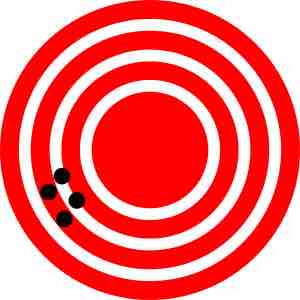Two Types of Errors
While conducting measurements in experiments, there are generally two different types of errors: random (or chance) errors and systematic (or biased) errors.
Every measurement has an inherent uncertainty. We therefore need to give some indication of the reliability of measurements and the uncertainties of the results calculated from these measurements. To better understand the outcome of experimental data, an estimate of the size of the systematic errors compared to the random errors should be considered. Random errors are due to the precision of the equipment , and systematic errors are due to how well the equipment was used or how well the experiment was controlled .

Low Accuracy, High Precision
This target shows an example of low accuracy (points are not close to center target) but high precision (points are close together). In this case, there is more systematic error than random error.

High Accuracy, Low Precision
This target shows an example of high accuracy (points are all close to center target) but low precision (points are not close together). In this case, there is more random error than systematic error.
Chance, or Random Errors
A random error makes the measured value both smaller and larger than the true value; they are errors of precision. Chance alone determines if the value is smaller or larger. Reading the scales of a balance, graduated cylinder, thermometer, etc. produces random errors. In other words, you can weigh a dish on a balance and get a different answer each time simply due to random errors. They cannot be avoided; they are part of the measuring process. Uncertainties are measures of random errors. These are errors incurred as a result of making measurements on imperfect tools which can only have certain degree of precision.
Random error is due to factors which we cannot (or do not) control. It may be too expensive, or we may be too ignorant of these factors to control them each time we measure. It may even be that whatever we are trying to measure is changing in time or is fundamentally probabilistic. Random error often occurs when instruments are pushed to their limits. For example, it is common for digital balances to exhibit random error in their least significant digit. Three measurements of a single object might read something like 0.9111g, 0.9110g, and 0.9112g.